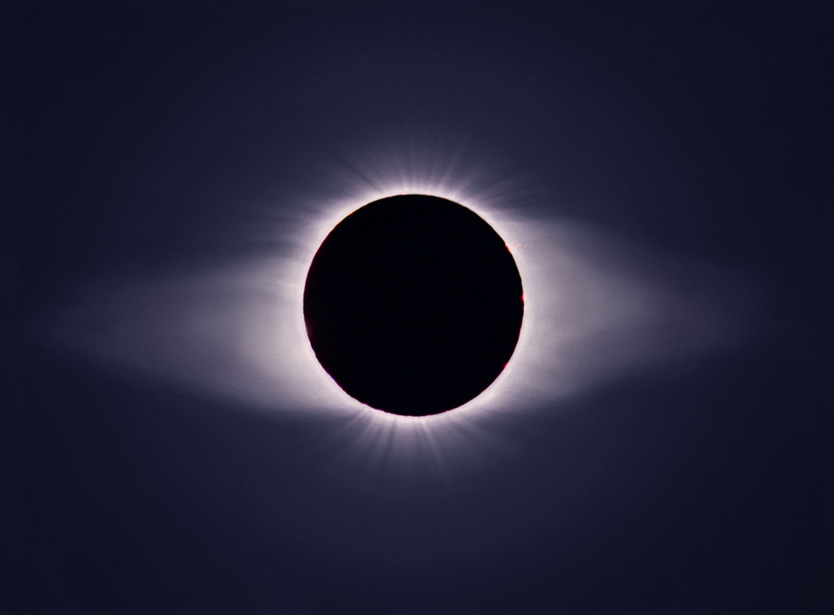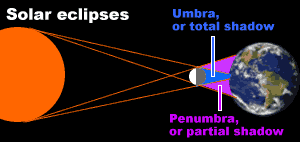Eclipses
- Eclipses= the light from the sun or the moon is going to be blocked for a period of time.

- Eclipses occur when the sun or the moon's lineament are in front of each other.

- There are two types of eclispes: Solar and Lunar

- Lunar eclipses happen more often, when the moon passes through the earths shadow- this is when the sun and the moon are on opposite sides of the earth.
- Solar eclipse when line up just right. This is when directly between the sun and the earth.

- Solar eclipses are very rare, the next predicted solar eclipse is in 2012. Usually the solar eclipses only happen every few years.
- The last solar eclipse was in 2010, and the next total solar eclipse will be November, 2012

How to view a solar eclipse:
Viewing a Total Eclipse
- 1Locate the small area of the world where the eclipse will occur - a band about 100 kilometers thick that stretches around half the planet. In most cases, you will have to travel to a point on the band to see the total solar eclipse.
- 2Join a group, if you can, that has at least one expert or veteran eclipse chaser. They can instruct you on the proper and best methods of enjoying the eclipse, and they can make sure you end up in the right place for the eclipse.
- 3Take along a small telescope or binoculars, which will reveal fantastic details not seen with the eye. A total solar eclipse lasts only a few minutes. During that time you can look directly at the sun without any filters.
- 4Wear a long-sleeved shirt, sunscreen, a hat and sunglasses, and have something refreshing to drink if you plan to say out during the entirety of the total solar eclipse (and the partial eclipses before and after).
- 5Expect a partial eclipse prior to the total eclipse. It will last over an hour. After the total eclipse will be another partial eclipse for over an hour.
- 6Notice, before and after totality, strange shadow effects visible on lightly colored, flat surfaces. These are called shadow bands. Not everyone sees the shadow bands; they are hard to spot.
- 7Lie in a recliner or deck chair or on a blanket. The best way to view a total solar eclipse is from a lounge chair that allows you to look up at the sun comfortably. A blanket spread on a hillside will work well, too.
- 8Try to relax, and be ready to see a lot as totality approaches and the sun becomes a sliver of light.
- 9Feel the temperature drop noticeably. There will be a slight chill in the air.
- 10Watch for birds, insects and other animals. They will think it is time to go to bed.
- 11Watch to the West as totality gets closer. You may be able to see the shadow of the moon sweeping toward you at over 1,800 miles per hour. As the shadow silently sweeps over you, it will get as dark as being outside during a full moon.
- 12Wait until someone yells, "Diamond ring," or "Second contact." Then it is safe to look at the sun.
- 13See the last bit of the bright sun going out and the corona shining around the dark moon. This is called the diamond-ring effect.
- 14Look for the bright red dots around the edge of the moon. These are called prominences. Binoculars will greatly improve your view, as will a small telescope.
- 15Look for the white crown of light around the moon. This is called the corona.
- 16Look to the north and south poles of the sun - the corona will be shaped in a brushed fashion.
- 17Look at the east and west edges of the sun - the corona will have streamers reaching out.
- 18Look for bright planets and stars briefly.
- 19Look at the horizon and sky color. You will see sunset all around going to twilight sky toward the eclipsed sun.
- 20Watch as new prominences grow out of the opposite side of the moon as the total eclipse nears completion. A brilliant diamond-ring effect will appear at the end of the eclipse. The sun's shadow will race off towards the east.
- 21Do not look at the sun anymore.
** How to look at the sun by: eHow contributor
No comments:
Post a Comment